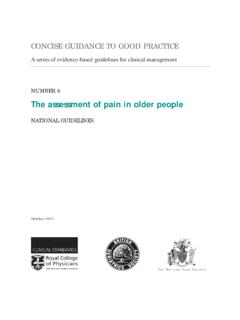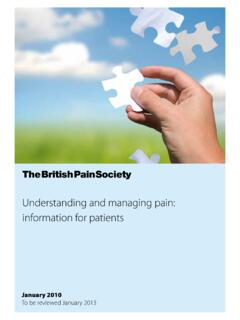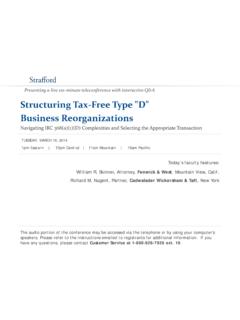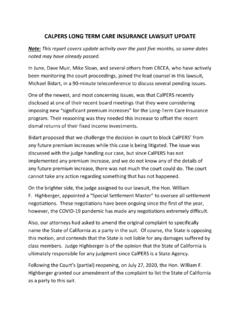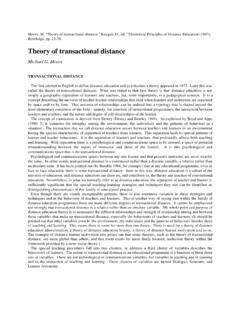Transcription of Outcome Measures - British Pain Society
1 January 2019 Outcome Measures2 Table of Contents1 Executive Summary 3 2 Introduction 4 Background 43 Methodology 54 Objectives 65 Pain Scales Numerical Pain Rating Scale (NPRS) Visual Analogue Scale 9 Verbal Rating Scale (VRS) 11 6 Pain Interference Roland & Morris Disability Index 13 Oswestry Low Back Pain Disability Questionnaire 157 Physical Functioning Brief Pain Inventory 178 Emotional Distress And Functioning Beck Depression Inventory (BDI-Ii) Centre For Epidemiologic Studies-Depression Scale 21 Hospital Anxiety And Depression Scale (HADS) 23 Short Form MOS-36 (SF-36)
2 25 Profile Of Mood States Pain Catastrophising Scale The Patient Health Questionnaire 2 30 The Pain Self-Efficacy Questionnaire (PSEQ) 31 9 Quality Of Life Euroqol 5D 32 10 Patient Reported Outcomes Patient Global Impression Of Change (PGIC) 34 11 Table 3512 The Working Party 3831 Executive summaryThis document is a combined project between the Faculty of Pain Medicine (FPM) and the British Pain Society (BPS).
3 Health service outcomes can be used to benchmark services against one another and against targets, and to improve patient care; NHS England is currently considering various Patient Reported Outcome Measures (PROMs). This document describes Outcome scales appropriate to pain management. It does not cover diagnostic and screening tools, nor direct measurement of physical performance, only scales that are completed by patients themselves before and after treatment. The scales are designed for use by cognitively intact adults over 16; other scales and methods are suitable for children and for people of any age with cognitive impairment. The document is necessarily a brief practical guide to the commonly used scales in the UK, not a comprehensive account of the qualities and performance of all possible pain has multiple effects on patients, so Outcome Measures cover several domains: Pain Quantity Pain Interference Physical Functioning Emotional Functioning Quality of Life Patient reported global ratingThe Initiative on Methods, Measurement and Pain Assessment in Clinical Trials (IMMPACT: ) outputs are a valuable resource, and several of its recommendations of scales are included here.
4 For each scale, a brief description is given with main advantages and disadvantages, and information on use and copyright. Dworkin RH, Turk DC, Farrar JT, Haythornthwaite JA, Jensen MP, Katz NP, et al. Core Outcome Measures for chron-ic pain clinical trials: IMMPACT recommendations , PAIN, 2005 Jan 1;113(1):9 IntroductionThis document is a joint project of the Faculty of Pain Medicine (FPM) of the Royal College of Anaesthetists and the British Pain Society (BPS) to provide guidance on the various available Outcome Measures used by pain services. This project has been supported by the national clinical reference group in BackgroundThe National Health Service (NHS) is moving towards Outcome -based commissioning which encourages value for money and better outcomes for patients.
5 NHS pain services are currently commissioned by different clinical commissioning groups (CCGs) based on their local infrastructure and requirements. NHS performance indicators, such as 18 weeks wait, are used to assess quality of services. Outcome Measures are not normally required to show service effectiveness, but this is currently changing and some CCGs are requesting outcomes to inform is defined as an unpleasant sensory and emotional experience associated with actual or potential tissue damage or described in terms of such damage. NHS pain services follow a biopsychosocial approach to manage pain. Chronic pain has a substantial effect on mood, quality of life and relationships.
6 It can affect the ability to work, leading to financial implications for the patient and the wider document was prepared to guide pain services across the country in selection of the most appropriate Outcome Measures for their needs. No single scale can meet all needs: the choice of Outcome /s for a service depends on the treatments offered, the aims of treatment, and on the population treated. 53 MethodologyThe Faculty of Pain Medicine and The British Pain Society appointed the working group. The primary aim was to provide guidance on the various available Outcome Measures used by pain services. By having a degree of uniformity to such Measures , we will be in a better position to influence the service level agreements both at a local and a national level.
7 The group was tasked to review already available and free to use Measures , easily used in the clinical and telephone follow-up environment. It should provide well-established and validated Outcome Measures that cover the domains of pain improvement, functional improvement, psychological improvement, and overall satisfaction applicable in the secondary and tertiary care setting. It is likely that a few Measures will be needed for different aspects of services and it is accepted that none will be perfect. New original research, and systematic/meta-analysis reviews were outside the remit of this working group communicated via email and teleconference due to geographical spread and to promote efficiency.
8 Most of the validated questionnaires analysed were from the Core Outcome Measures for Chronic Pain Clinical Trials: IMMPACT Recommendations . Additional Outcome Measures were added if the group agreed that they were commonly used in pain clinics, and were well validated with evidence in the use of chronic pain. It should be noted that the analysis of all available Outcome Measures was not done, due to the clear objectives assigned to the working group, and the time frame involved. It is envisaged that this document will continually evolve, based on feedback, experience of its use, and the availability of further evidence. 64 ObjectivesThis document provides a shortlist of scales used to assess outcomes of pain management, with reasonable psychometric properties and most without undue restrictions on use.
9 Some are copyright protected, or require payment, particularly if for commercial (profit-making) rather than research use. Reliability: The quality of being trustworthy or of performing consistently well. The degree to which the result of a measurement, calculation, or specification can be depended on to be accurate. A measure has high reliability if it produces similar results under consistent conditions. If one person takes the same personality test several times and always receives the same results, the test is reliable. Validity: In its purest sense, this refers to how well a scientific test or piece of research actually Measures what it sets out to, or how well it reflects the reality it claims to represent.
10 If the results of the personality test claimed that a very shy person was in fact outgoing, the test would be and validity are independent of each other. A measurement may be valid but not reliable, or reliable but not valid. Suppose a bathroom scale was reset to read 10kgs lighter. The weight it reads will be reliable (the same every time you step on it) but will not be valid, since it is not reading your actual to change: It must be able to detect small, but clinically significant changes in a phenomenon over time. This may be done by comparing longitudinal Measures of the same Outcome , at baseline and discharge or a series of Measures over departments are looking for one scale, EuroQol (EQ5D-5L) is currently being adopted by the NHS England as a key Outcome measure in other areas such as knee and hip surgeries.


